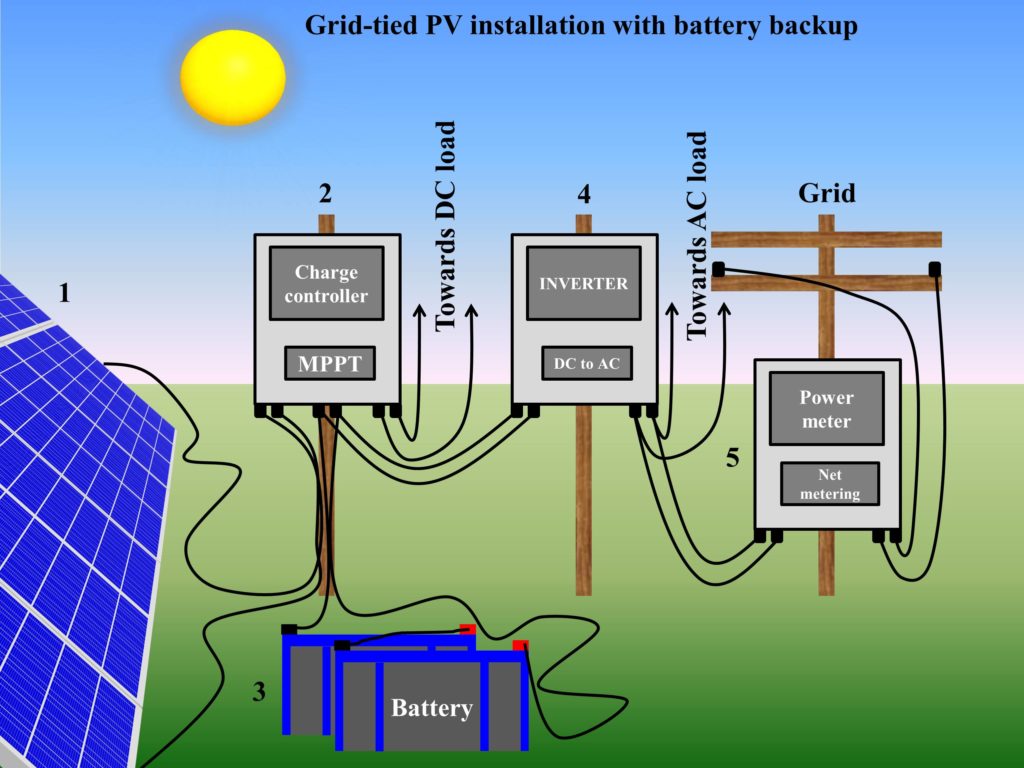Three main types of PV installations
Depending on the locality, economics, and availability of the grid, there are a few types of PV installations, but their inherent components remain almost the same. These types of PV installations are specifically designed for each locality. The three major types of PV installations are mentioned below.
Grid-tied PV installation with battery backup
This type of installation is connected to the grid that is why it is named grid-tied. Therefore, this type of installation can provide surplus generated power to the grid and if net-metering is enabled, the owner of the PV installation can have a deduction in the electricity bill. Moreover, battery backup is particularly provided which can sustain the power requirements even at night when solar energy from the sun is not available. This type of PV installation has the sole purpose of being run on solar energy, and that is why the cost needed to install such a system is higher than other types of PV installations. This increased cost comes from (1) an increased number of panels (to increase the power rating of the system to charge the battery backup), and (2) due to the addition of battery backup (usually more than one batteries are needed to power the system for which PV system is installed). Moreover, the batteries incur running costs because they are needed to be replaced every 3-5 years. A typical grid-tied installation is shown in Fig. 1.

GRID-TIED PV INSTALLATION WITHout BATTERY BACKUP
In this type of installation, the solar panels are connected to a charge controller, which is connected to an inverter that has a connection to the grid through a power meter. There is no battery backup in this installation and the solar PV system is active only in the morning and noon when the solar energy from the sun is available. The additional power generated during sunshine hours is supplied to the grid, and when the sunshine is not available, the power is taken from the grid. This type of installation is a hybrid installation, where power is generated through a PV system during the day and power is taken from the grid during the night. This type of installation is scalable with some energy being generated from the PV system and the rest of the power being taken from the grid. With the passage of time, more panels can be added to the system to fully electrify a building, and provide surplus power to the grid. A visual representation of such PV installation is provided in Fig. 2.

Standalone PV systems and their installation in remote areas
The standalone PV installations are particularly suited for remote areas where access to the grid is not available. In such conditions, the PV installation serves as an independent power generating unit and can provide power to areas that are not present on the grid. The standalone PV installation is economical in some instances than taking the grid to remote areas or making power plants in these areas. Technically speaking, if standalone systems are installed in remote areas, the use of an inverter in such installations should not be required, but since most of our loads work on AC, an inverter is still required for such installations. The modern inverters also cover the functionality of charge controllers and they can be employed to discard charge controllers and save their cost. to This PV installation is directly connected to DC loads, which is cost-effective. Now if such type of installation is used to run a machine such as a motor in tube wells, no battery backup is needed. But if the standalone system needs to provide power to residential or commercial areas, then the battery backup is again needed. These cases are depicted in Fig. 3(a-b), with the incorporation of charge controllers, which can be discarded if inverters have the functionality of charge controllers.

